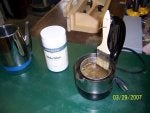My jug of Titebond Yellow (probably PVA, but it was put in an old ketchup{catsup?} plastic bottle a while back so not sure) just gave its last gasp so I'll need to stop at my favorite big box store for a new supply. The yellow glues have some weather resistance I've found. But is a resorcinol type for another buck or two per bottle actually a better choice for all around use? I do have and use Gorilla foaming glues occasionally as well as epoxy(dislike) but they for sure aren't needed or wanted for inside work. Additionally, I'm not 'into' old time work and hide glues though appreciate those that do use it and successfully
Thanks !!!
Thanks !!!







